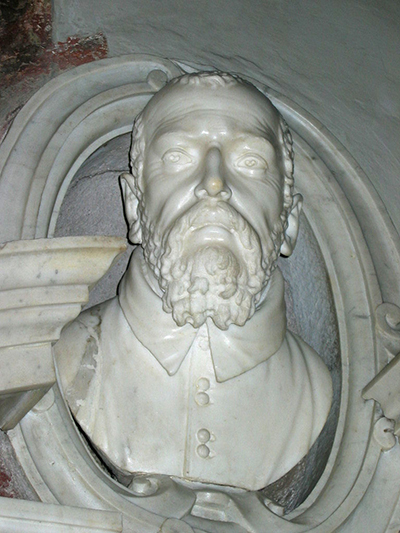This is a sculptural Bust of Giovanni Battista Santoni made from marble when Bernini was only around twelve years old.
It is an excellent example of the technical prowess of the artist at a young age which would have made contemporary sculptures twice his age, and more, jealous. Experts estimate that the bust was created sometime around 1610 and contains a number of features that reveal the guidance and influence the artist received from his father at the time.
Details such as the way the marble flows from the skin to the hair, and in some of the features of the bust show the father's influence on the young sculptor. The bust is carved from marble and exhibits conventions and aspects of funerary monuments that were common in Rome at that time.
This work is believed to be one of Bernini's earliest and it was made to form part of Santoni's tomb. Though dated to around 1610 the exact date is uncertain and some say it was made from 1613 to 1616, while other scholars have dated it as early as 1609. Either way, it was created by the artist at a very young age and displays his early talent and skill at crafting marble. Giovanni Battista Santoni was consecrated as the Bishop of Alife in 1568 and 18 years later in 1586, he was made the Bishop of Tricarico.
Shortly after Pope Sixtus V made his ascension to the papal throne be appointed as his majordomo Battista. Sadly he was not long in this position and within two years after this appointment, Santoni died. It is said that around 1610, Santoni's nephew commissioned this bust to be made of his uncle after he himself had been appointed to the bishopric. A posthumous honouring of his dead uncle.
The bust is life sized and resides in an Oval frame which has mouldings behind it and in between a pediment (which is broken) in a Mannerist style. Bernini also created the framing - an oval frame along with another more elaborate framing which is adorned with three cherubim which some say the artist used as models for his mythological statues the puttis.
The bust was set in Rome, in the church of Santa Prassede where it still resides today. Santa Prassede as it currently is was commissioned in 780 by Pope Hadrian I and is built upon the the remains of an older structure erected in the 400s. It is a minor basilica in Rome and an ancient titular church and well worth a visit to see the Bernini bust of Santoni along with its beautiful and ancient Byzantine mosaics. The church is known for the bones removed from the catacombs and placed in the church and has inspired people throughout the ages. Robert Browning took inspiration from the church for his poem 'The Bishop Orders His Tomb at Saint Praxed's Church.'




